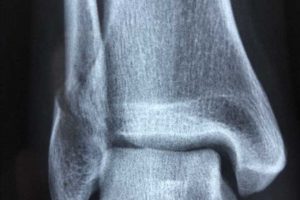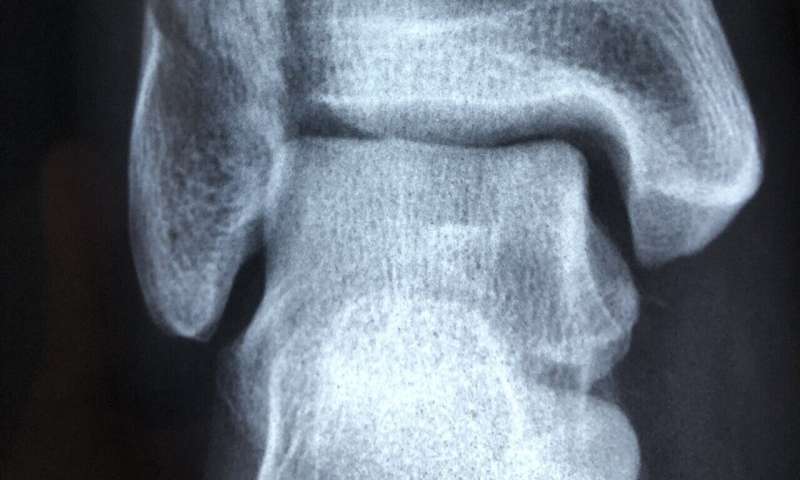Obesity linked to higher risk of broken bones in women


New research being presented at the European Congress on Obesity (ECO) in Maastricht, the Netherlands (4-7 May), has found that women with obesity and overweight, particularly women with high waist circumference, are more susceptible to fractures than those with normal weight. In men, however, underweight, not overweight, is associated with a greater risk of broken bones.
Obesity has long been thought to help protect against fractures. This is because mechanical loading on bones, which increases with body weight, helps increase bone mineral density, an important determinant of bone strength.
However, recent studies have suggested that the relationship between obesity and fracture risk varies depending on sex, the skeletal site studied and definition of obesity used (body mass index [BMI] vs. waist circumference).
To find out more, Dr. Anne-Frederique Turcotte, Endocrinology and Nephrology Unit, CHU de Quebec Research Center, Quebec City, Canada, and colleagues, analyzed data from CARTaGENE, a prospective population-based cohort of almost 20,000 individuals aged 40-70 years from Quebec, Canada.
Participants in CARTaGENE were selected randomly between 2009 and 2010, assessed once at recruitment and followed through healthcare administrative databases until March 2016.
BMI and waist circumference (WC, a measure of abdominal obesity) were measured at recruitment.
Fractures were identified using a previously validated algorithm. During a median follow-up of 5.8 years, 497 women and 323 men sustained a fracture (820/19,357 participants).
There were 415 major osteoporotic fractures (MOFs—fractures of the hip, femur, spine, wrist or humerus), 260 in women and 155 in men.
There were 353 distal lower limb (the part of the leg below the knee) fractures (e.g. fracture of ankle, foot and lower tibia or shinbone), 219 in women and 134 in men.
There were 203 distal upper limb (the forearm from the elbow down) fractures (e.g. fracture of the wrist, forearm or elbow),141 in women and 62 in men.
(Note, some fracture sites, such as wrist, were included in more than one category.)
In women, greater WC was linearly associated with an increased risk of fracture. For each 5cm (two inch) increase in WC, the risk of fracture at any site was 3% higher and the risk of a distal lower limb fracture was 7% higher. The association between WC and ankle fractures was particularly strong.
In women, greater BMI was associated with a greater risk of distal lower limb fractures. Compared with women with a BMI of 25 kg/m², those with a BMI of 27.5-40 kg/m² showed a greater risk of distal lower limb fractures. The increase in risk rose linearly from 5% in those with a BMI of 27.5 kg/m², to 40% in those with a BMI of 40 kg/m².
Women with a BMI of 22.5 kg/m² had a 5% lower risk of distal lower limb fractures than those with a BMI of 25 kg/m².
It isn’t known why obesity is associated with a higher risk of fractures in women. However, most fractures are a result of a fall and falls are more common in people with obesity. The ankle, unlike the hip and thighbone, is not protected by soft tissue, which could make it more prone to breaking during a fall.
Dr. Turcotte adds: “Waist circumference was more strongly associated with fractures in women than BMI. This may be due to visceral fat—fat that is very metabolically active and stored deep within the abdomen, wrapped around the organs—secreting compounds that adversely affect bone strength.
“We also know that people with obesity take longer to stabilize their body, when they trip, for example. This is particularly pronounced when weight is concentrated at the front of the body, suggesting that individuals with distribution of body fat in the abdominal area may be at higher risk of falling.”
In men, increases in BMI and WC were not significantly associated with fractures. However, men with underweight were at higher risk of distal upper limb fractures than those with normal weight. Men with a BMI ≤17.5 kg/m² were twice as likely to have distal upper limb fracture as men with a BMI of 25 kg/m².
The researchers say a larger number of fractures in men is needed to determine whether this is a true result or whether the pattern for men follows that for women.
The analyses were adjusted for a number of potential confounders: age, menopausal status, ethnicity, marital status, education, income, area of residence, smoking status, alcohol consumption, physical activity level, supplemental calcium and vitamin D intake, history of fracture and comorbidities and medications known to influence fracture risk.The study’s authors say: “Our findings show that the relationship between obesity and fractures is complex and varies by sex. In women, there was a linear relationship between waist circumference and the incidence of fracture at any site and at the distal lower limb, particularly at the ankle.
“Similar results were observed for women with a BMI between 27 and 40 kg/m². In men however, there was no relationship between obesity and the risk of fracture, although a BMI in the underweight range was associated with a higher risk of some fractures.”
Dr. Turcotte adds: “Our finding that obesity and, in particular, abdominal obesity, is linked to a higher risk of fractures in women has major public health implications.
“We know that individuals with obesity who sustain a fracture are more likely to have other health problems that may cause slower rehabilitation, increase the risk of post-operative complications and malunion (fractures that may not heal properly), generating substantial healthcare costs.
“The aging of the population and the rising incidence of obesity may lead to rising rates of fractures in coming years.
Source: Read Full Article